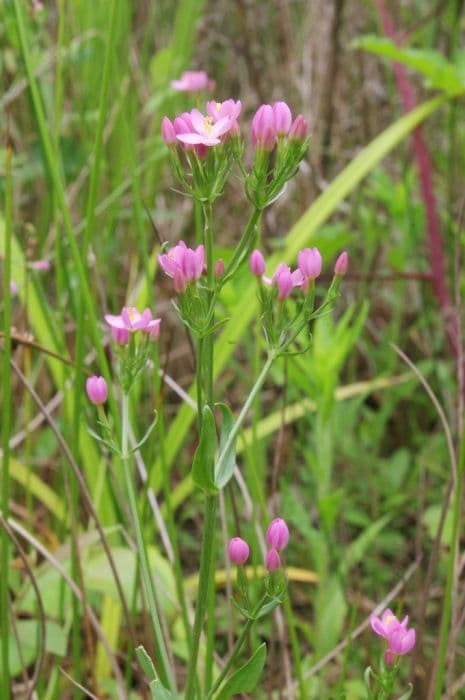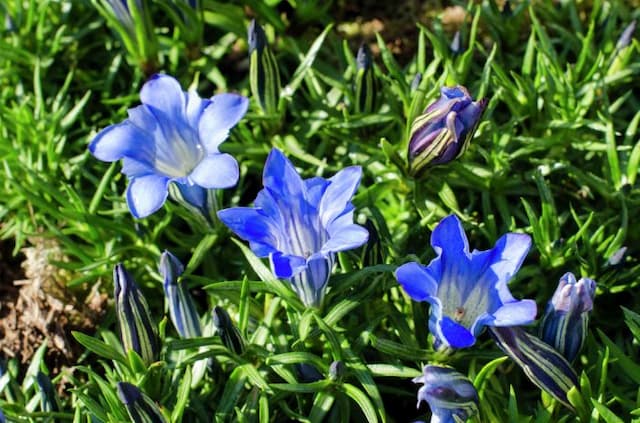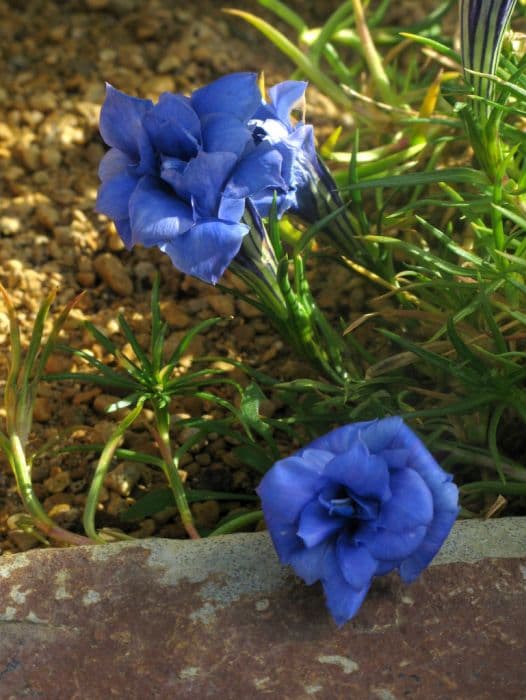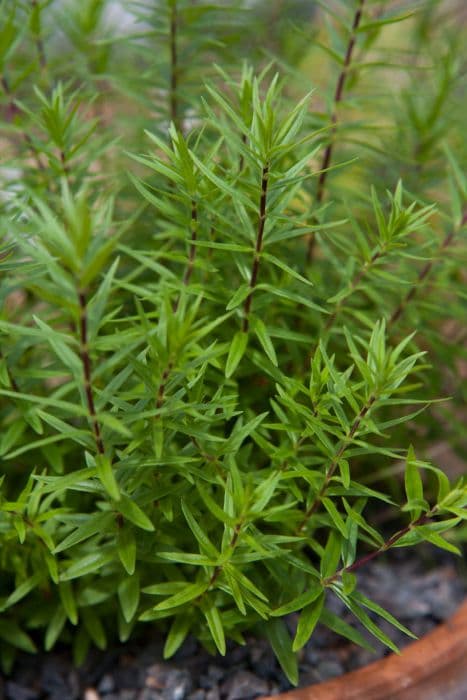Macaulay's Gentian Gentiana × macaulayi

ABOUT
Gentiana × macaulayi, commonly known as Macaulay's gentian, is characterized by its strikingly vivid blue trumpet-shaped flowers, which are a standout feature in any garden. The blooms typically showcase a deep hue of blue, occasionally with lighter or white fringes, and may present a spotted pattern within the throat, adding to their ornamental appeal. These flowers are arranged in clusters, giving the plant a lush, full appearance when in bloom. The foliage of Macaulay's gentian is equally attractive, consisting of opposite leaves that are lance-shaped. The leaves are bright green in color and serve as a beautiful backdrop that contrasts the intense blue of the flowers. The plant tends to form a neat, compact mound, contributing to its refined look in a landscape setting. Macaulay's gentian has a herbaceous habit, meaning that it dies back to the ground during the winter months, but will reemerge from its roots in the spring. Its overall form is tidy, making it a popular choice for gardeners seeking a plant with both stunning blooms and an orderly growth habit. In essence, the beauty of this plant lies in its eye-catching floral display and well-maintained foliage.
About this plant
 Names
NamesFamily
Gentianaceae
Synonyms
Macaulay's Gentian
Common names
Gentiana × macaulayi.
 Toxicity
ToxicityTo humans
The Gentiana × macaulayi, commonly known as Macaulay's gentian, does not have a well-documented profile of toxicity for humans in the available scientific literature as of my last update. Thus, there are no specific symptoms of poisoning or toxic consequences reported for ingestion of this plant part by humans. If you suspect poisoning from any plant, it is essential to seek medical attention.
To pets
Like the information available for humans, there is also no well-documented toxicity profile for Macaulay's gentian (Gentiana × macaulayi) in pets, such as dogs and cats. As a result, specific symptoms of poisoning and the consequences of ingesting this plant are not reported. However, it's always a good practice to keep an eye on pets as they can react differently to various plants. If you suspect your pet has ingested a potentially poisonous substance, consult a veterinarian as soon as possible.
 Characteristics
CharacteristicsLife cycle
Perennials
Foliage type
Deciduous
Color of leaves
Green
Flower color
Blue
Height
1-2 feet (30-60 cm)
Spread
1-2 feet (30-60 cm)
Plant type
Herb
Hardiness zones
5
Native area
Hybrid
Benefits
 General Benefits
General Benefits- Ornamental Appeal: Gentiana × macaulayi adds visual interest to gardens and landscapes thanks to its vibrant blue flowers.
- Attracts Pollinators: The flowers attract bees and butterflies, contributing to the pollination of nearby plants.
- Low Maintenance: This hybrid gentian is generally easy to care for, requiring minimal maintenance once established in the right conditions.
- Adaptability: It can thrive in a variety of soil types, as long as they are well-draining, making it versatile for different garden settings.
- Drought Tolerance: Once established, Gentiana × macaulayi can be quite resilient to periods of low water availability.
- Seasonal Interest: The plant blooms in late summer to early fall, providing color and interest during a time when other plants may be fading.
 Medical Properties
Medical PropertiesThis plant is not used for medical purposes.
 Air-purifying Qualities
Air-purifying QualitiesThis plant is not specifically known for air purifying qualities.
 Other Uses
Other Uses- Gentian violet dye source: The roots of the Gentiana × macaulayi can be used to extract a natural dye for textiles and artworks.
- Photography: The vivid blue flowers of the plant can be used in plant-based photography projects to create natural contrasts and highlights.
- Education: This hybrid is studied in botany and horticulture programs to better understand hybridization and plant genetics.
- Culinary decoration: The flowers, being non-toxic, can be used as an attractive and edible garnish in high-end gastronomy to add color to dishes.
- Eco-friendly confetti: Dried petals of the plant can serve as biodegradable confetti for outdoor celebrations, reducing environmental impact.
- Insect attraction in gardens: Planting Gentiana × macaulayi can attract pollinators such as bees and butterflies, promoting garden health.
- Natural indicators: The inherent pigments in the petals could potentially be used in classrooms to demonstrate acid-base color changes in simple chemistry experiments.
- Landscape photography: Their striking appearance makes them a popular subject for landscape and garden photographers looking for vivid color and natural beauty.
- Botanical art: Live plants or pressed flowers are used by botanical artists to create detailed drawings or pressings that highlight the plant's beauty.
- Flower arranging: With their colorful blooms, the stems can be used as part of floral arrangements or bouquets for events and home decoration.
Interesting Facts
 Feng Shui
Feng ShuiThe Gentiana is not used in Feng Shui practice.
 Zodiac Sign Compitability
Zodiac Sign CompitabilityThe Gentiana is not used in astrology practice.
 Plant Symbolism
Plant Symbolism- Endurance: Gentians are known for their hardiness and ability to thrive in difficult conditions, and therefore symbolize enduring challenges with strength and resilience.
- Determination: The plant's growth in challenging terrains and climates represents a strong will and determination to succeed against the odds.
- Victory: In some traditions, gentians symbolize a reward after a long struggle, akin to reaching a mountain peak after a tough climb.
- Integrity: Their unyieldtiness and steadfastness can represent moral integrity and the upholding of one's beliefs in the face of adversity.
 Water
WaterTo water a Gentiana, often referred to as a Gentian, you should maintain consistent moisture without waterlogging the soil. Water the plant deeply once a week, providing it with approximately 0.5 gallons to ensure the soil is thoroughly moistened, but allowing the top layer of soil to dry slightly between waterings. Adjust watering frequency during hotter and drier periods to possibly twice a week, but be cautious of overwatering as Gentians are prone to root rot in soggy conditions.
 Light
LightGentians thrive in full to partial sunlight, making them perfect for a spot that receives bright light for at least 6 hours a day. They perform best when they are sheltered from the intense afternoon sun, so a position that offers morning sunlight and afternoon shade would be ideal.
 Temperature
TemperatureGentians are cold-hardy and prefer cooler temperatures, with an ideal range between 50°F to 70°F. They can withstand temperatures as low as 20°F, but should be protected from sustained cold below this point. During summer, keep Gentians in a cooler spot if temperatures regularly exceed 80°F.
 Pruning
PruningPruning Gentians is primarily for shaping and removing spent flowers to encourage new growth and blooming. Prune after the main blooming season, in late summer or fall, cutting back the flowering stems by about half. Pruning every year helps maintain a compact and healthy plant.
 Cleaning
CleaningNot needed
 Soil
SoilThe best soil mix for Gentiana × macaulayi, commonly known as Gentian, should be well-draining and loamy. A mixture containing equal parts garden soil, coarse sand, and peat moss can promote good drainage and aeration. The ideal soil pH for Gentian is slightly acidic to neutral, ranging between 5.5 and 7.0.
 Repotting
RepottingGentian plants typically need to be repotted every 2 to 3 years to refresh the soil and accommodate root growth. They do not rapidly outgrow their pots, so frequent repotting is unnecessary. Care should be taken not to damage the roots during the repotting process.
 Humidity & Misting
Humidity & MistingGentian plants prefer a moderate humidity level and do not require excessively high humidity. Aim for a humidity level around 50% for ideal growing conditions. Maintaining good air circulation around the plant also helps prevent fungal diseases which can occur if humidity is too high.
 Suitable locations
Suitable locationsIndoor
Place Gentians in bright indirect light and monitor moisture.
Outdoor
Choose a sunny spot with moist, well-drained soil for Gentians.
Hardiness zone
3-7 USDA
 Life cycle
Life cycleGentiana × macaulayi, commonly known as Macaulay's Gentian, typically begins its life cycle with seed germination, which occurs in spring under cool, moist conditions. The emerging seedlings establish a rosette of leaves at the soil surface and grow slowly, developing a root system. As the plant matures, usually in its second year, it produces upright stems that bear the characteristic trumpet-shaped, blue flowers that are often marked or spotted. After pollination, which is assisted by insects attracted to the flowers, the plant sets seed in the form of a capsule containing numerous small seeds. These seeds are dispersed by wind, water, or animals, thereby propagating the species and completing the reproductive cycle. This perennial herb may undergo dormancy during winter, with its above-ground parts dying back, to re-emerge and continue its life cycle when conditions become favorable in the following spring.
 Propogation
PropogationPropogation time
Spring to summer
Propogation: The most popular method of propagation for Gentiana × macaulayi, also known as Macaulay's Gentian, is by seed. Seed propagation typically begins in late winter or early spring to give the plants a full growing season. Seeds should be sown in a well-draining seed starting mix, lightly covered with soil, and kept moist until germination. It is important to maintain a consistent temperature, ideally around 65 to 70 degrees Fahrenheit (18 to 21 degrees Celsius), for successful germination. Since this plant can be slow to germinate, patience is key—germination can take several weeks to a few months. Once seedlings are large enough to handle, they can be pricked out and potted on into individual containers to continue their growth before eventually being planted out in their final positions.









